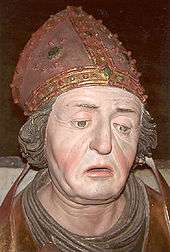Rupert of Salzburg
| Rupert of Salzburg | |
|---|---|
|
Saint Rupert depicted wearing a mitre, typical of a bishop | |
| Bishop | |
| Born | 660? |
| Died |
27 March 710 Salzburg, Austria |
| Venerated in |
Roman Catholic Church Eastern Orthodox Church |
| Feast |
24 September [1] 27 March |
| Attributes | Holding a container of salt; wearing clerical clothes including mitre; holding a crosier |
| Patronage | Salzburg, The State of Salzburg, Austria, salt miners |
Rupert of Salzburg (German: Rupprecht,[lower-alpha 1] Latin: Robertus, Rupertus; c. 660[lower-alpha 2] – 710 AD) was the Bishop of Worms, the first Bishop of Salzburg, and the abbot of St. Peter's in Salzburg. He was a contemporary of Childebert III, King of the Franks[2] and is a Saint in the Roman Catholic and an Eastern Orthodox Churches.[3] Rupert is also a patron saint of the Austrian state of Salzburg.
Life
Holy tradition states that Rupert was a scion of the Frankish royal Merovingian family,[3] related to the Robertian dynasty, most likely the Count palatine Chrodbert.

Although, Rupert was at first accepted as a wise and devout bishop, the mostly pagan community eventually came to reject him and forced him out of Worms.The Duke Theodo of Bavaria the requested that he come to Bavaria to help spread the Catholic faith.
Rupert moved to Altötting where he converted the locals. He sailed down the Danube river, visiting many towns, villages and forts. Soon he had converted a large area along the Danube southward to the border with the Pannonian lands that were ruled by the Avars. Here he stayed at Lorch (the former Roman city of Lauriacum, today part of Enns).
Warlike conditions made him abandon plans of missionary work in the Avar territories. Instead he proceeded to the ruined Roman city of Juvavum where he made his base and renamed the city "Salzburg" (Latin: Salisburgum).[4] Rupert was able to build on ancient Early Christian traditions that were already in place. He re-established St. Peter's Abbey and laid the foundations of Salzburg Cathedral that was finished by his successor Vergilius. He founded the Benedictine nunnery of Nonnberg beneath the Festungsberg fortifications, where his niece Saint Erentrude became the first abbess.
Rupert also introduced education and other reforms. From the hands of Duke Theodo of Bavaria, he received estates around Piding and Reichenhall, where he promoted the development of the local saltworks.
Rupert reportedly died on Easter Sunday around 710.[5] According to other sources, he returned to his hometown of Worms where he died in 717. His remains were transferred to Salzburg Cathedral by 774.
Veneration
In accordance with Christian tradition, St. Rupert's feast day is celebrated by the Eastern Orthodox Church on the anniversary of his repose, March 27.[3] In Austria, it is 24 September.[6]
Gallery
 An Austrian stamp of 1948 depicting a statue of Saint Rupert
An Austrian stamp of 1948 depicting a statue of Saint Rupert Etching of Saint Rupert by Bock after Johann Wolfgang Baumgartner
Etching of Saint Rupert by Bock after Johann Wolfgang Baumgartner Head of a Gothic style statue of Saint Rupert
Head of a Gothic style statue of Saint Rupert Saint Rupert, as founder of a church ("fundator ecclesiae")
Saint Rupert, as founder of a church ("fundator ecclesiae")
Notes
References
- ↑ German language regional calendar, September, Institut für Praktische Theologie
- 1 2 Ulrich Schmid (1912). "St. Rupert". The Catholic Encyclopedia. 8. Robert Appleton Company. Retrieved 2007-03-27.
- 1 2 3 "Saints of Salzburg", Orthodox England
- ↑ Delehaye 1911.
- ↑ Lives of Sts. Robert (Rupert) and Erendruda, The St. Pachomius Orthodis Library, 1994
- ↑ "Archived copy". Archived from the original on June 27, 2007. Retrieved March 27, 2008.
Sources
![]() Delehaye, Hippolyte (1911). "Rupert, St". In Chisholm, Hugh. Encyclopædia Britannica (11th ed.). Cambridge University Press.; Endnotes:
Delehaye, Hippolyte (1911). "Rupert, St". In Chisholm, Hugh. Encyclopædia Britannica (11th ed.). Cambridge University Press.; Endnotes:
- Bibliotheca hagiographica Latina, (Brussels, 1899), n. 7390-7403
- W. Levison, “Die älteste Lebensbeschreibung Ruperts von Salzburg” in Neues Archiv für ältere deutsche Geschichtskunde, xxviii. 283 seq.
- Hauck, Kirchengeschichte Deutschlands (3rd ed.), i. 372 seq.
External links
 Media related to Rupert of Salzburg at Wikimedia Commons
Media related to Rupert of Salzburg at Wikimedia Commons- Lives of Sts. Robert (Rupert) and Erendruda
